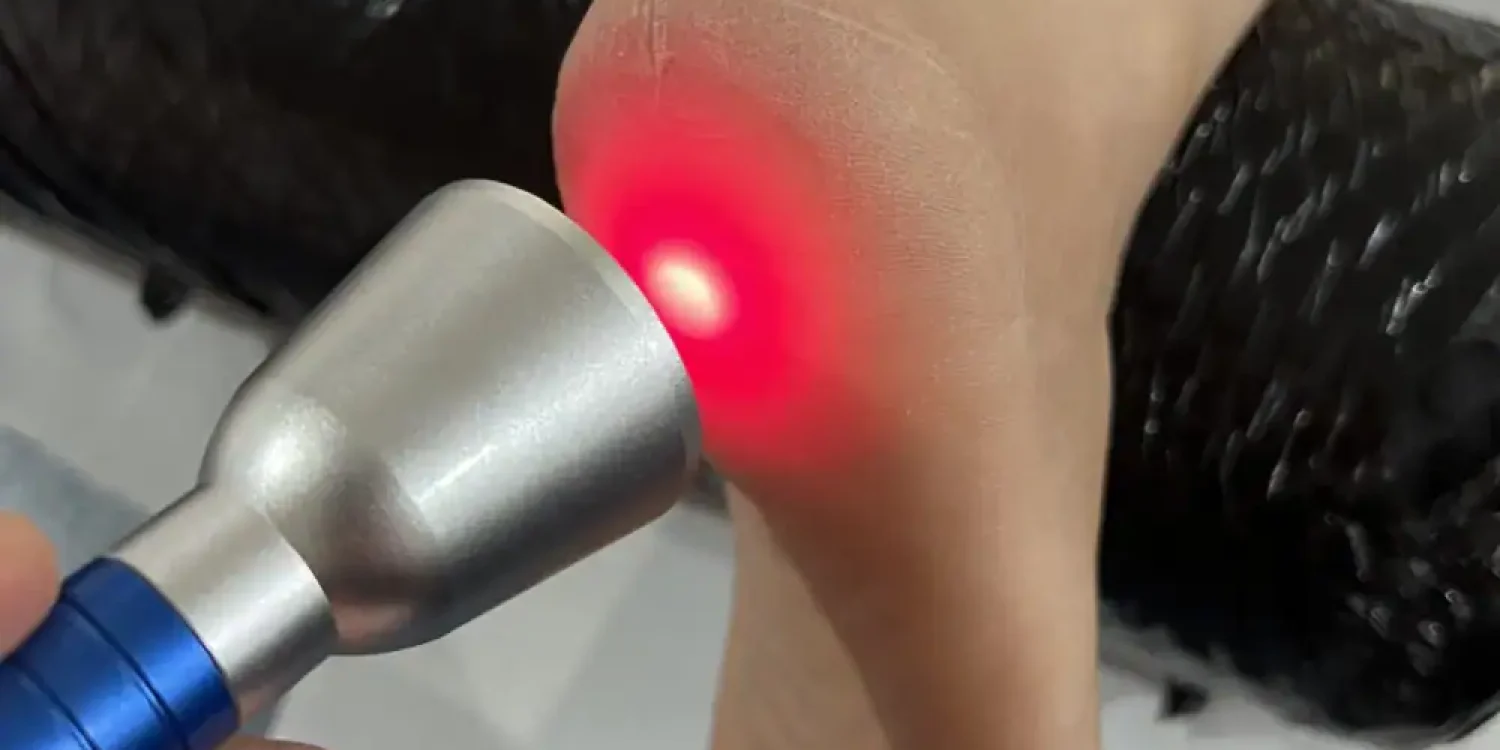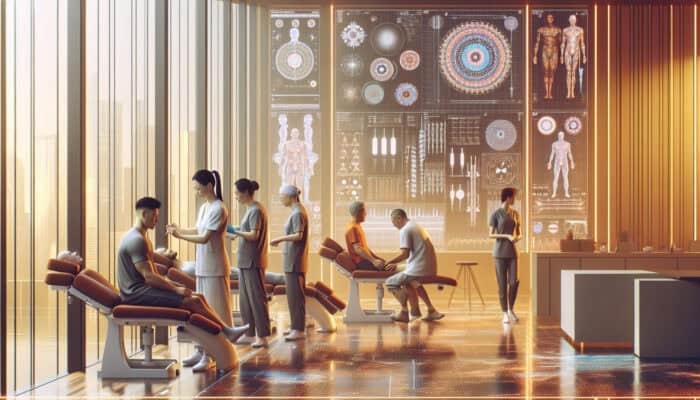Experience Pain Relief with Cutting-Edge Laser Treatment
High-intensity laser therapy stands out as a cutting-edge approach to pain relief and inflammation treatment. Unlike other laser therapies that use low-intensity lasers for superficial treatments, high-intensity lasers penetrate deep into tissues, offering superior and longer-lasting benefits.
If you’re seeking relief from pain or injury, rest assured that high-intensity laser therapy is in the hands of experts. With their extensive training and experience, these professionals can diagnose your illness and craft a unique treatment plan tailored to your needs.
Key Takeaways
- High-Intensity Laser Therapy is a noninvasive treatment that uses light energy to promote healing and reduce pain.
- Laser light therapy stimulates cellular activity and increases blood flow to the affected area.
- Benefits of laser pain therapy include reduced inflammation, improved range of motion, and faster healing times.
- Laser therapy can treat various conditions, including back pain, knee pain, sports injuries, arthritis, and neuropathy.
- To find a high-intensity laser therapy provider near you, consult your healthcare provider or search online for reputable clinics.
How Laser Light Therapy Works
 High-intensity laser therapy delivers concentrated light energy to tissues and cells in the body. This light triggers a series of cell metabolic processes, leading to pain and inflammation relief and accelerated healing.
High-intensity laser therapy delivers concentrated light energy to tissues and cells in the body. This light triggers a series of cell metabolic processes, leading to pain and inflammation relief and accelerated healing.
The laser beam illuminates the mitochondria and the cellular power plants. Adenosine triphosphate (ATP) is essential for cellular metabolism, and this connection enhances its production. Intense pulsed light treatment has the dual benefit of improving cellular function and speeding up the healing process by increasing ATP production.
For high-intensity laser therapy to be effective, the dosage and frequency must be carefully controlled. The therapeutic impact might only materialise if the energy is high enough, and tissue injury could result from excess energy. A specialist in high-intensity laser therapy will determine the best course of action in frequency and dosage.
Benefits of Laser Pain Relief Therapy
High-intensity laser therapy is a beneficial treatment for individuals experiencing inflammation and pain. The therapy helps to reduce both pain and inflammation, which is a significant advantage. When laser light is applied, the body releases endorphins, natural painkillers. This ultimately results in a reduction of discomfort and pain, making you feel more comfortable overall.
Aside from relieving pain, high-intensity laser therapy speeds healing and promotes tissue regeneration. Increased cellular processes, including ATP synthesis, encourage new blood vessels, collagen, and other necessary components for tissue repair. The healing process and recovery period can be accelerated using this.
One of the most comforting aspects of high-intensity laser therapy is its natural and risk-free nature. Unlike medications or surgeries, which carry their own set of risks and side effects, high-intensity laser therapy offers a safe and non-intrusive alternative. Many individuals find this aspect particularly appealing, as it does not involve injections or incisions.
Conditions Treated with Laser Therapy
High-intensity laser therapy can relieve an extensive list of medical issues. Laser therapy has shown promise in alleviating pain associated with a variety of medical issues, including musculoskeletal disorders, sports injuries, arthritis, neuropathy, and post-operative pain.
Reduce inflammation and alleviate discomfort using high-intensity laser therapy for musculoskeletal pain, like back or neck pain. Additionally, it can help relieve pain and speed up the healing process for sports injuries, including sprains and strains.
Similarly, high-intensity laser therapy can alleviate arthritis pain to a considerable degree. The laser light improves joint function and relieves pain by lowering inflammation and increasing collagen formation.
Also, high-intensity laser therapy can help with neuropathy, a condition marked by damaged nerves and symptoms including tingling or numbness. Laser light can alleviate neuropathy pain and improve topical nerve function.
If you have any medical concerns, you should talk to your doctor before beginning high-intensity laser therapy. Laser therapy may or may not be the best treatment for you, depending on their evaluation of your unique condition.
Laser Therapy for Back Pain: How It Can Help
Pain in the back is a common ailment that can significantly diminish one’s standard of living. If you suffer from back discomfort, high-intensity laser therapy may relieve and speed up recovery.
One common cause of back pain is inflammation; laser therapy lowers inflammation locally. Relieving pain and increasing movement, the laser light triggers the release of anti-inflammatory chemicals.
Laser treatment has shown encouraging results in treating back pain. After receiving laser therapy, several patients reported much less discomfort and better function. The rapid and persistent comfort that patients report after laser therapy sessions is a common theme in their testimonies.
Note that to effectively cure back pain with laser therapy, a correct diagnosis and thorough treatment plan are required. You should consult a medical expert who can diagnose your back pain and provide a treatment plan tailored to your unique requirements.
Laser Therapy for Knee Pain: What to Expect
 Knee discomfort is prevalent and can significantly affect a person’s day-to-day activities. If you suffer from knee discomfort, high-intensity laser therapy can help alleviate your symptoms and speed up healing.
Knee discomfort is prevalent and can significantly affect a person’s day-to-day activities. If you suffer from knee discomfort, high-intensity laser therapy can help alleviate your symptoms and speed up healing.
One common cause of knee discomfort is inflammation, which laser therapy can alleviate. The laser light triggers the release of anti-inflammatory chemicals, relieving pain and increasing movement.
Laser treatment has shown encouraging results in the treatment of knee pain. After receiving laser therapy, several patients reported much less discomfort and better function. The rapid and persistent comfort that patients report after laser therapy sessions is a common theme in their testimonies.
Laser treatment for knee discomfort should only be initiated after a thorough evaluation by a qualified medical practitioner. Their expertise will allow them to determine what’s causing your knee discomfort and craft a unique treatment regimen.
Laser Therapy for Sports Injuries
Mild aches and pains, such as sprains and strains, and more serious ones, like ligament tears and fractures, are prevalent among sportsmen. Athletes may find that high-intensity laser therapy speeds up their recuperation and gets them back on the pitch more quickly.
Injured areas experience less pain and inflammation as a result of laser therapy, which speeds up the healing process. Athletes can recuperate faster thanks to the laser light’s ability to trigger cellular processes that hasten the healing and regeneration of injured tissues.
Laser treatment for athletic injuries has shown encouraging results. Many athletes have said that their pain levels significantly decreased and their performance significantly improved after laser therapy. The rapid and effective recovery that patients report following laser therapy sessions is a common theme in their testimonies.
Like with any injury, it is wise to speak with a healthcare provider before beginning laser treatment for a sports injury. After determining the extent of your damage, they can craft a unique treatment regimen to meet your requirements.
Laser Therapy for Arthritis Pain Relief
Inflammation and joint pain are hallmarks of arthritis, a degenerative joint disorder. High-intensity laser therapy may comfort arthritis sufferers and improve joint function.
One common way that laser therapy alleviates arthritis pain is by lowering inflammation in the afflicted joints. The laser light triggers the release of anti-inflammatory chemicals, relieving pain and increasing movement.
There has been encouraging evidence that laser therapy can alleviate the discomfort associated with arthritis. Numerous individuals have reported substantial improvement in joint function and pain relief. Patients’ testimonials frequently mention the enduring relief they feel following laser therapy sessions.
It is wise to talk to a doctor before beginning laser treatment for arthritic pain, as one should before starting treatment for any chronic illness. They can determine how bad your arthritis is and devise a unique treatment strategy.
Laser Therapy for Neuropathy
Nerve damage and symptoms like tingling, burning, or numbness are known as neuropathy. When it comes to neuropathy, high-intensity laser therapy has the potential to alleviate symptoms and enhance nerve function.
Laser therapy stimulates cellular processes to alleviate neuropathy pain and increase nerve function. The laser light speeds healing and relieves pain by increasing blood flow to the injured nerves.
Laser treatment for neuropathy has shown encouraging success rates. Numerous individuals have observed substantial improvement in nerve function and reduction in pain following laser therapy treatments. According to patient comments, laser treatment improves patients’ quality of life.
It is wise to talk to a doctor before beginning laser treatment for neuropathy, as is the case with any health issue. Based on that, they can determine how bad your neuropathy is and develop a unique treatment strategy for you.
Finding a High-Intensity Laser Therapy Provider Near You
Suppose you are considering high-intensity laser therapy as a treatment option for your pain or injury. In that case, finding a reputable provider near you is essential. Here are some tips to help you find the right provider:
1. Research credentials and experience: Look for providers with the necessary credentials and expertise in high-intensity laser therapy. Check their qualifications and certifications to ensure they can provide this type of treatment.
2. Read reviews and testimonials: Look for reviews and testimonials from previous patients to get an idea of their experiences with the provider. This can give you valuable insights into the effectiveness of the treatment and the quality of care provided.
3. Ask for recommendations: Contact your healthcare provider, friends, and family who may have undergone high-intensity laser therapy. They can recommend a reputable provider in your area.
You can anticipate resting comfortably on a treatment table during a high-intensity laser therapy session as the laser is applied to the affected area. Depending on the ailment being addressed, the session duration can range from ten to twenty minutes.
Modern pain and inflammation sufferers now have access to high-intensity laser therapy, which has several advantages. High-intensity laser therapy promotes healing while decreasing inflammation and pain, achieving relief and an improved quality of life.
Get medical help immediately if you’re in discomfort or if you think high-intensity laser therapy might help your condition. Depending on your requirements, a healthcare provider focusing on high-intensity laser therapy can create a tailored treatment programme.
Injuries and discomfort should not be obstacles in your path. To begin living pain-free, locate a provider of high-intensity laser therapy in your area. With proper preparation and administration, the positive effects of high-intensity laser therapy are within reach.
This article on Array may be of particular interest to you if you seek information regarding high-intensity laser therapy as a pain relief. In this article, Array will review the advantages and efficacy of high-intensity laser therapy in treating chronic pain and musculoskeletal disorders. In addition to discussing the possible benefits of laser therapy as a noninvasive substitute for conventional pain treatments, the article delves into the science underlying its operation. The article on Array delves further into this subject.
FAQs
What is high-intensity laser therapy?
High-intensity laser therapy is a noninvasive medical treatment that uses a high-powered laser to stimulate healing and reduce pain.
How does high-intensity laser therapy work?
High-intensity laser therapy delivers a concentrated beam of light energy to the affected body area. This energy penetrates deep into the tissues, stimulating cellular activity and promoting healing.
What conditions can high-intensity pain relief treat?
High-intensity laser therapy can be used to treat a wide range of conditions, including chronic pain, arthritis, sports injuries, and post-surgical pain.
Is high-intensity laser therapy safe?
When performed by a licenced medical professional, high-intensity laser therapy is considered safe and effective. However, some risks and side effects may be associated with the treatment, such as skin irritation or burns.
How long does a high-intensity laser therapy session last?
The length of a high-intensity laser therapy session can vary depending on the condition being treated and the severity of the pain. Typically, sessions last between 5 and 20 minutes.
How many high-intensity laser therapy sessions are needed?
The number of high-intensity laser therapy sessions needed can vary depending on the patient’s condition and the individual patient. Some patients may experience significant pain relief after just one session, while others may require multiple sessions over several weeks.
Does insurance cover high-intensity laser therapy?
Insurance coverage for high-intensity laser therapy can vary depending on the individual policy and the specific condition being treated. Patients should check with their insurance provider to determine if the treatment is covered.
References
- Huang, Z., Ma, J., Chen, J., Shen, B., Pei, F., Kraus, V. B. (2015). The effectiveness of low-level laser therapy for nonspecific chronic low back pain: a systematic review and meta-analysis. Arthritis Research & Therapy, 17(1), 360. https://pubmed.ncbi.nlm.nih.gov/26667480/
- Bjordal, J. M., Lopes-Martins, R. A., Iversen, V. V. (2006). A randomised, placebo-controlled trial of low-level laser therapy for activated Achilles tendinitis with microdialysis measurement of peritendinous prostaglandin E2 concentrations. British Journal of Sports Medicine, 40(1), 76-80.
- Chow, R. T., Johnson, M. I., Lopes-Martins, R. A., Bjordal, J. M. (2009). Efficacy of low-level laser therapy in managing neck pain: a systematic review and meta-analysis of randomised placebo or active-treatment controlled trials. The Lancet, 374(9705), 1897-1908.
- Schubert, V., Fritsch, C., Wittig, S., Brückner, T., Grasel, E., Stein, G. (2014). Low-Level Laser Therapy to Reduce Chronic Pain: A Review of Reviews. The Open Journal of Orthopedics, 4(01), 31-39.
- Moore, K. C., Hira, N., Kumar, P., Jones, G. G. (2017). High-Intensity Laser Therapy: A Review. Frontiers in Physics, 5, 26.


























15 Comments
I find the advancements in high-intensity laser therapy fascinating! It’s incredible how this noninvasive approach can address chronic pain and expedite healing. I’ve read about patients experiencing significant improvements in their mobility after just a few sessions.
This introduction to high-intensity laser therapy is fascinating and highlights an important aspect of modern pain management. As someone who has experienced chronic pain, I can appreciate the advancement in treatment options available today. Traditional methods, such as pain medications and physical therapy, often come with limitations and side effects.
It’s great to hear that you found the introduction to high-intensity laser therapy engaging, especially given your personal experience with chronic pain. The landscape of pain management is continually evolving, and it’s important for patients to be aware of new options that may offer relief beyond traditional methods.
“Discover in-depth insights and valuable resources tailored to enhance your understanding by exploring the link below.”
https://mcrtherapies.co.uk/ig
You raise a valid point about the limitations of traditional options like medications and physical therapy, especially for chronic pain. High-intensity laser therapy represents a shift in how we might approach pain management, emphasizing healing without the side effects that often accompany conventional treatments.
I’m glad you found the introduction insightful! If you’re interested in exploring how high-intensity laser therapy can make a difference in managing chronic pain, check out this link for more information.
https://mcrtherapies.co.uk/ezi
It’s interesting to see how high-intensity laser therapy is shaping up as a go-to solution for pain relief. I remember when I first heard about it, I was skeptical—laser therapy sounded almost futuristic! But after learning how it penetrates deeper into tissues compared to traditional methods, it makes sense why so many are seeing positive results.
I’m really intrigued by the potential of high-intensity laser therapy! The distinction between this and low-intensity laser treatments is a game changer for those of us dealing with chronic pain or injuries. I had a friend who struggled for years with knee pain, and after trying various treatments, she finally found relief through a similar therapy. The noninvasive nature and ability to stimulate cellular activity is remarkable. I’m curious how it compares to other modern therapies like stem cell treatment or regenerative medicine—do you think we’ll see a trend towards combining these technologies for even better outcomes? I’d love to hear others’ experiences or thoughts on how we can further integrate such innovative approaches into our healthcare systems!
It’s interesting to see the excitement around high-intensity laser therapy, especially how it offers a distinct approach compared to low-intensity treatments. The noninvasive aspect really opens up possibilities for those who have tried and struggled with numerous therapies, similar to your friend’s experience with knee pain. It seems like there’s a growing body of evidence supporting the benefits of laser therapy in different settings, which could make a real difference for many.
It’s great to hear about your friend’s positive experience with high-intensity laser therapy. That noninvasive aspect really is a significant advantage for many dealing with chronic pain, and it seems to resonate with a broader movement toward approaches that prioritize patient comfort while still delivering effective results.
It’s encouraging to hear how effective your friend’s experience was with high-intensity laser therapy. The ability of these treatments to trigger cellular activity does provide a fascinating avenue for addressing chronic pain. It’s a noninvasive option that a lot of people overlook compared to more traditional methods.
“I’m glad to hear you’re excited about high-intensity laser therapy! If you’re looking for more information on how this innovative approach can complement other treatments like stem cell therapy, check out this resource that dives deeper into the topic.”
https://mcrtherapies.co.uk/fb
It’s interesting how high-intensity laser therapy is gaining traction as a noninvasive option for addressing chronic pain. I’ve noticed that many people tend to lean toward more traditional methods, perhaps out of habit or familiarity, but the potential of newer treatments like this opens up a whole new discussion about how we approach pain management.
It’s great to see how much interest there is in alternative therapies; if you’re considering holistic options for your wellness journey, exploring acupuncture for weight loss might be a worthwhile addition to your research.
‘Find Acupuncture for Weight Loss Near Me’
https://mcrtherapies.co.uk/find-acupuncture-for-weight-loss-near-me/.
It’s interesting to hear about your friend’s experience with knee pain and how high-intensity laser therapy provided her relief. The distinction between high-intensity and low-intensity treatments really does open up new avenues for those struggling with chronic pain. I’ve been reading about how high-intensity laser therapy can promote faster recovery by enhancing cellular activity and reducing inflammation, which is so beneficial for conditions that can be tough to manage.
You’ve hit the nail on the head with high-intensity laser therapy! It’s like the superhero of physical treatments, swooping in to save the day for folks dealing with chronic pain. Your friend’s knee saga is a classic reminder of just how frustrating chronic issues can be—it’s as if our bodies sometimes decide to audition for a role in a really long, dramatic play.
“Thanks for sharing your thoughts! If you’re interested in exploring how high-intensity laser therapy and other innovative treatments can complement each other, check out this resource for more insights.”
https://mcrtherapies.co.uk/fb
The potential of high-intensity laser therapy is definitely fascinating, especially when you think about how it can address chronic pain and promote healing in ways that traditional methods sometimes struggle with. Your friend’s experience really highlights the journey many people go through to find effective relief. It’s interesting to think about how individual responses can vary widely, even among similar conditions.
High-intensity laser therapy seems to hold incredible promise in the realm of pain management and rehabilitation. I’ve recently come across personal accounts from friends and colleagues who have tried various forms of laser therapy, and the results have been encouraging. One friend, for instance, struggled for years with chronic back pain due to an old injury. After undergoing several sessions of high-intensity laser treatment, she reported not only significant pain relief but also an improved ability to engage in activities she had long avoided.
It’s really interesting to hear about your friends’ experiences with high-intensity laser therapy. It sounds like it has made a significant impact on her quality of life, especially when it comes to engaging in activities that she might have shied away from due to pain. Chronic pain can be such a heavy burden, and finding effective treatments can sometimes feel like searching for a needle in a haystack.